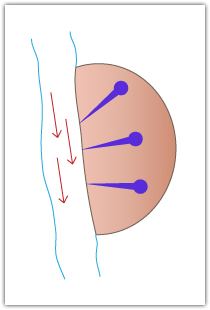Acini and minor canaliculi
 We said the minor canaliculi serve to transport prostatic secretions from the acini to the urethra. The canaliculi draining the central acini are tortuous in form while those draining the peripheral acini are straight and joined to the urethra in a position which is countercurrent to the urine stream (see fig.).
We said the minor canaliculi serve to transport prostatic secretions from the acini to the urethra. The canaliculi draining the central acini are tortuous in form while those draining the peripheral acini are straight and joined to the urethra in a position which is countercurrent to the urine stream (see fig.).
These anatomical details prompt the following inference: given the tortuous course of their canaliculi, periurethral acini are more easily obstructed by inflammation and are more likely to release substances and even produce stones. Peripheral acini with their straight canaliculi are more subject to urinary reflux and urethral bacteria.
This has major therapeutical implications because if true, periurethral prostatitis might benefit temporarily from strong gland expression while no improvement would be seen in cases of peripheral prostatitis because the straight canaliculi are not prone to stasis.
